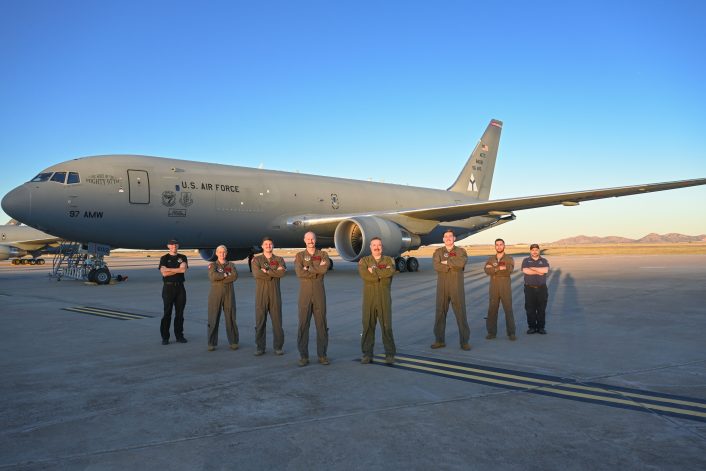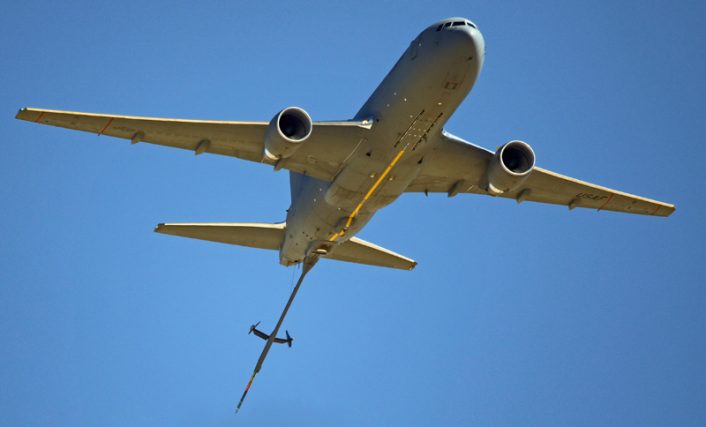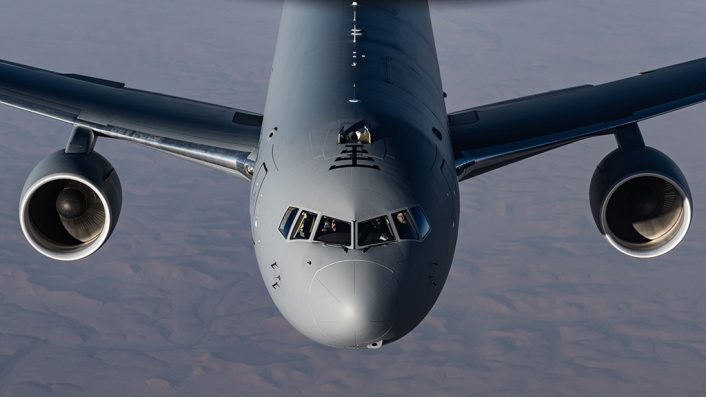The 56th Air Refueling Squadron conducted the first KC-46 air display at an air show in Texas, recently.
The 56th ARS from Altus Air Force Base, Oklahoma, made history on Nov. 9, 2024, by introducing the “world’s first KC-46 Pegasus demonstration team” during the Wings and Warriors Fly-In in San Marcos, Texas.
Similarly to the missions of other U.S. demo teams, the goal of the KC-46’s demo team is to highlight the Pegasus’s unique capabilities and the continued evolution of the Air Force’s tanker fleet.
“Being part of this demo team is incredibly meaningful, especially as a woman in this profession,” said Tech. Sgt. Lacy Pickett, KC-46 demo team boom operator in a story published by the 97th Air Mobility Wing. “We’re demonstrating how much we’ve achieved in the KC-46 community and what we’re truly capable of.”
U.S. Air Force Maj. Gary Sowa, lead of the KC-46 demo team within the 97th Operations Group, described the team’s performance at the air show in Texas
The team demonstrated the KC-46’s refueling capabilities and its slow-speed maneuvering. We executed a high-speed pass with the boom extended at an altitude of 500 feet, followed by a low-speed pass with the gear and flaps deployed, giving spectators a closer look at the aircraft’s versatility.
With each demonstration, we’re not only showcasing the KC-46’s capabilities but also building the team, evolving its legacy, and inspiring future generations of Airmen.”
Considering that U.S. KC-46s have taken part in airshows in the past, performing flypasts with the boom extended and, in some cases, with receivers in trail, there are chances a dedicated demo team will further expand the routine, by adding additional maneuvers to the air display.
Noteworthy, the U.S. Air Force has a KC-135 Demonstration Team based at Fairchild Air Force Base, WA.

KC-46A Pegasus
The KC-46A represents the beginning of a new era in air-to-air refueling capability for the joint force, the U.S. Air Force says on the page on its website dedicated to the tanker. The aircraft has been in development since Feb. 24, 2011, and its initial flight took place in Dec. 2014. The current contract, with options, provides Air Mobility Command an inventory of 179 KC-46A tankers. The first KC-46A was delivered to McConnell Air Force Base, Kansas on Jan. 25, 2019.
A Boeing 767 derivative like the KC-767, the KC-46A Pegasus the U.S. Air Force selected to replace the older KC-135 features a stretched fuselage, different engines, cockpit, wings and boom: in other words, it’s almost a completely different tanker. One of the main differences that makes it stand out compared to previous USAF tankers is the absence of a rear-facing window for the refueling boom operator, replaced by a camera system.

The KC-46 was born from the KC-X program, for which Boeing submitted its KC-767 tanker proposal in 2007. The aircraft, however, was based on the in-development 767-200LRF (Long Range Freighter), rather than the -200ER as the KC-767, differing by combining the -200ER fuselage, -300F wing, gear, cargo door and floor, -400ER digital flightdeck and flaps, upgraded engines and “sixth-generation” fly-by-wire boom.
Boeing proposal was selected as the winning one in 2011 and received the designation KC-46A, with the first flight in 2015. Since then, the program has been plagued by deficiencies which required redesigns, causing delays and over $7 billion charges incurred by Boeing.
The aircraft’s fuel can be pumped through the boom, drogue and wing aerial refueling pods (or WARPs). All KC-46As are capable of being configured with WARPs, and when equipped, the aircraft is capable of multi-point simultaneous aerial refueling. The Boom Operator controls the boom, centerline drogue and WARPs during refueling operations from an Air Refueling Operator station that includes panoramic displays that give the ARO “wing-tip to wing-tip situational awareness”.
The KC-46A can accommodate a mixed load of passengers, aeromedical evacuation and cargo capabilities. Two high-bypass turbofans power the KC-46A to takeoff at gross weights up to 415,000 pounds. Depending on fuel storage configuration, the aircraft can carry a palletized load of up to 65,000 pounds of cargo. The KC-46A can carry up to 18 463L cargo pallets. Seat tracks and the onboard cargo handling system make it possible to simultaneously carry palletized cargo and passenger seats in a variety of combinations. The KC-46A is also equipped with a number of self-protection, defensive and communication features making it more survivable in a contested environment.
As of Jan. 2024, the KC-46 has six category 1 deficiencies, which could cause loss of an aircraft, injury, or death, according to the Air Force classification. Work is ongoing to fix them once for all.

We provided details about them, in an article we posted earlier this year, when the Italian Air Force announced its plan to suspend a 1.2 billion Euro program to replace its KC-767A withe the KC-46. Here’s an excerpt:
The first, possibly the most important, is related to the cameras which replaced the boom operator’s window. There are two groups of cameras: the Remote Vision System (RVS), which focuses on the boom, and a second group which provides a panoramic view to the rear of the tanker. Both systems struggle under certain environmental conditions and Boeing is working on an RVS 2.0, expected in late 2025.
Another problem is related to the boom, and specifically an actuator inside the boom which prevents the A-10C to be refueled. In fact, the A-10 can’t generate enough force to stay connected to the boom due to its low speed, so the hydraulic actuator provides that force to keep the boom rod in the receptacle. A new actuator is expected by 2026.
Then, there are product quality issues, which involve three separate parts of the aircraft: drain masts for its auxiliary power unit (APU), a seal for its fuel manifold and a drain line that runs near the cockpit. Specifically, the APU’s drain masts showed a tendency to crack, solved with additional reinforcements.
The fuel manifold, which runs 555 feet throughout the plane, is fitted with flex couplings throughout so that it can bend in flight. Incorrect positioning of the coupling’s seals enabled fuel to seep out of the inner tube into the outer one, so Boeing implemented a new flex seal.
The last one was related to the AAR receptacle on top of the cockpit, specifically the receptacle drain line, which empties liquid out but is at risk of cracking and could cause fuel to leak into the cockpit. A fix has been found and should be implemented by next year.
Adding to this, there is another problem with a key feature, the Wing Aerial Refueling Pods. The WARPs, mounted on the aircraft’s wings, are designed to refuel two aircraft simultaneously, however the Director of Operational Test & Evaluation’s 2023 annual report mentioned the pods did not yet enter Initial Operational Test & Evaluation (IOT&E) because they didn’t achieve the FAA supplemental-type certification.
Specifically, the WARPs did not meet certification requirements for cowling bird strike, lightning tolerance, and wiring corrosion protection. The Air Force stated that certification is ongoing and IOT&E should start this year.

